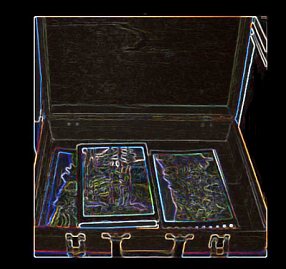
short-listed for Prix poesie-media 2009, Biennale Internationale des poetes Val de Marne, France, May, 2009
Featured in: Judy Malloy: Retrospective, the 2012 Electronic Literature Organization Conference, West Virginia University, Morgantown, WV, June 20-23, 2012
Other Exhibitions: Language-Driven Installation Art, Electronic Literature Organization Conference, Brown University, Providence, RI, 2010; E-Poetry 2009, Center of Contemporary Art Barcelona, Spain
Conferences, Readings, Presentations:Berkeley Center for New Media Roundtable, UC Berkeley, February 11, 2010, The Future of Writing, UC Irvine, CA, November, 2008; ; radio interview and reading, Cover to Cover, KPFA, December, 2008
"...In Paths of Memory and Painting, the viewer is asked to navigate the poem by clicking the lexia that attracts them. An ethereal narrative emerges based on individual decision. The resulting form reflects the viewer’s desire for a certain path. The act of reading poetry and choosing what portion comes next alters the traditional form and a feeling of intimacy emerges between the viewer and the computer..." -- Mary Gagler, Curator, Technology Becomes Them
As if music, playing on a barge on a river, was imagined in the hills of Northern California -- celebrating painters rather than royalty and playing in three suites -- Paths of Painting and Memory sets painter Dorothy Abrona McCrae on a recollected journey that begins with painting in the California Hills during World War II.
In circa 2008, while I was hosting Art California in partnership with the California Studies Association at UC Berkeley, I was immersed in the work of the diverse, extraordinary painters of California Impressionism and earlier/later: African American Grafton Tyler Brown; Japanese American Chiura Obata; Mexican American Xavier Martinez; Marion Kavanaugh Wachtel and her husband Elmer Wachtel, who rode on horseback across the California mountain passes; disabled artists Anna Althea Hills and Granville Redmond; Mary deNeale Morgan on the shores of Monterey; the men of Society of Six; the spirit of legendary William Keith; the painters at UC Berkeley, including Erle Loran and Margaret Peterson; and later the Bay Area figurative school, Joan Brown, David Park, and Elmer Bischoff, among many others. As Dorothy recollects her past, their cameo appearances form an integrated basso continuo to Paths of Memory and Painting.
Throughout Paths of Memory and Painting, composition and content details, as well as navigations suggestions are available by clicking on "about" from within each part.
" showcases Malloy’s finely honed craft as a poet, storyteller, and creator of hypertexts." - Leonardo Flores, I heart e-poetry
In Part I, recollected on this early morning, a reading experience is created, in which a painter's thoughts while returning to painting in the hills are densely revealed. Lexias are piled one atop of another in eight adjacent stacks in an array -- disclosing new information as the reader confronts multiple paths.
Part II, when the foreground and the background merged, moves to a series of intimate conversations in a restaurant in which Dorothy recollects dinner with an army officer stationed in Berkeley in 1944, while in a parallel lexia, she remembers her later years as a post-war student at Cal.
As Part III, paths of memory and painting, begins, Dorothy is sitting in a cafe in Berkeley in the present time, waiting for her husband, Sid, to return from an expedition to Berkeley bookstores. The interface for Part III is an array of three side-by-side lexia trails that advance polyphonically. The work is meant to resemble the experience of listening to a piece of polyphonic music, in which the reader might hear different things every time he or she listens to it, until finally the whole is comprehensible.
Paths of Memory and Painting is copyright 2008-2010 Judy Malloy.
Last update, August 27, 2017.
